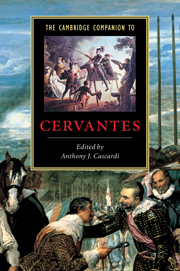Book contents
- Frontmatter
- 1 Introduction
- 2 The historical and social context
- 3 Cervantes and the Italian Renaissance
- 4 Don Quixote and the invention of the novel
- 5 The influence of Cervantes
- 6 Cervantes’ other fiction
- 7 Writings for the stage
- 8 Humor and violence in Cervantes
- 9 Psyche and gender in Cervantes
- 10 Cervantes and the New World
- Appendix: electronic editions and scholarly resources
- Index
- Series List
10 - Cervantes and the New World
Published online by Cambridge University Press: 28 May 2006
- Frontmatter
- 1 Introduction
- 2 The historical and social context
- 3 Cervantes and the Italian Renaissance
- 4 Don Quixote and the invention of the novel
- 5 The influence of Cervantes
- 6 Cervantes’ other fiction
- 7 Writings for the stage
- 8 Humor and violence in Cervantes
- 9 Psyche and gender in Cervantes
- 10 Cervantes and the New World
- Appendix: electronic editions and scholarly resources
- Index
- Series List
Summary
Cervantes launched his writing career in 1585 with the publication of La Galatea, an unfinished, and today unreadable, bucolic fantasy. Some twenty years later he would reassess this first fiction, during the scrutiny of Don Quixote's library, as inconclusive: “it proposes something, and concludes nothing” (i, 6). One thing this early work did propose was the importance of transatlantic poetry. La Galatea includes, among other classical furniture, a Muse who catalogues an impressive number of Spanish poets installed in “the faraway Indies.” Why this strange encounter between classical Arcadia and early modern America? The publishing date of Cervantes' first book coincided with what Fernand Braudel describes as a new “physics of Spanish policy”: “For in the 1580s the might of Spain turned towards the Atlantic. It was out there, whether conscious or not of the dangers involved, that the empire of Philip II had to concentrate its forces and fight for its threatened existence. A powerful swing of the pendulum carried it towards its transatlantic destiny.” Evidently Cervantes wanted to be carried there too. This essay, which discusses his lifelong preoccupation with the Indies, is divided into three parts. We begin with a biographical section, largely focused on Cervantes’ efforts to emigrate to the New World. This is followed by a survey of various kinds of American images found in his work, including their links to the Chronicles of the Indies. The essay closes with a look at two interlocking New World themes: Don Quixote as a “conquistador ” and the conquistadores as “quixotic. ”
- Type
- Chapter
- Information
- The Cambridge Companion to Cervantes , pp. 206 - 225Publisher: Cambridge University PressPrint publication year: 2002
- 1
- Cited by

